David Armstrong & Sandy Mill
"I love the adventure and romance, of never really knowing what is over the horizon or just around the next island. I value the discipline of self-reliance, and freedom from our over regulated society. It develops confidence and provides great satisfaction. I love the ocean’s mood, its beauty, its majesty, its calm, and its power!"
David Armstrong 2006
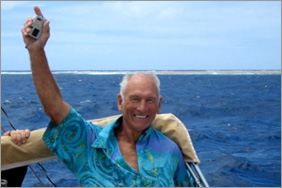
David Armstrong 2009
David was born in England and educated at Blundells School and the Architectural Association (AA) in London but to New Zealand parents, so he has a foot in both camps. After serving with the ANZAC’s in the trenches in The Great War, his father, E W Armstrong, won a scholarship to study architecture at The AA School in London. After working in Burma for a large British firm supervising the construction of The Law Courts and The Port Offices in Rangoon, he returned fleetingly to NZ. Whilst there, he won a competition for the Robert McDougal Art Gallery in Christchurch. He married David’s mother, Eve Gaddum of Gisborne, and they returned to London together where he set up in private practice. He part owned the Bristol Channel Pilot cutter ‘Alanna’ and then the West Solent class racer Erin (W19) moored at Gin’s Hard on the Beaulieu River close to Bucklers Hard. At an early age under his father’s guidance, David learnt to sail - cruising and racing around the Solent. Erin spent the war years in a shed at Berthon’s Boat Yard, in Lymington where, by coincidence, he and Sandy worked on ‘MAYA’ partly rebuilding her interior to accommodate both their families.

Bloodhound
In the late 30’s David still recalls seeing those majestic ‘J’ boats racing off Cowes. “I think the breathtaking beauty of those magnificent craft under a full press of canvas had a profound influence on me.” he said. In the ‘50’s, whilst an architectural student in London, he joined the RORC, participating in many ocean races including the Fastnet. At the end of The Channel Race in 1956 he was sailing aboard ‘Bloodhound’ when the crew had to abandon ship off Selsey Bill being rescued by lifeboat in winds gusting to 120 mph causing sharp sand particles to be sucked into the blown spume (See K Adlard Coles account in ‘Heavy Weather Sailing’).
On the West Coast of Scotland he later crewed an 8 metre cruiser/racer for several years. As a result of this experience, in 1962 David was invited to skipper the 40 ft yawl ‘Rembrandtine’ for a lengthy Mediterranean cruise from Marseilles to the Greek Islands.
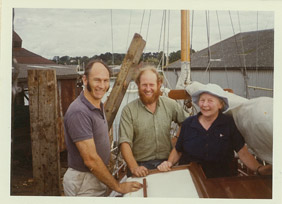
David and Sandy with Phyl Baldwin - preparing to
start work, 1971
From there he hitch hiked in stages largely overland back to NZ. However en route, he met up again in Singapore with some German globetrotting students with whom he had previously been scrambling around The Mount Athos Peninsular in Northern Greece. They had by now sold their VW camper in Afghanistan and with the proceeds, in Port Sweetenham, built a small Chinese junk the ‘Eng Yong’. David joined forces with them again to teach them the finer points of sailing, their small junk rigged craft had tanned sails made from Lend Lease flour sacks and full-length bamboo battens. From Singapore they sailed across the busy Malacca Strait and down the east coast of Sumatra and Java and then on to Bali. Together they had some unique adventures, including being boarded by pirates in The Bunka Strait, and were detained for some days in a Javanese detention camp because there was a hostile confrontation between Singapore and Indonesia at the time - the British Embassy in Jakarta having just been torched. David left ‘Eng Yong’ on the beautiful Island of Bali and managed to work his passage on a small trading vessel back to Singapore, ‘Eng Yong’ sailed on to Darwin Australia where they sold her to a crocodile hunter. He then visited Hong Kong and Saigon, at the start of war in Vietnam. David spent several months hitching around Japan studying mainly early Japanese religious architecture, which has had a profound influence on his work. Finally he headed south to Australia and New Zealand by passenger ship.
During the late 50’s David, through mutual friends, met Sandy Mill. They worked together at Max Fry’s architectural practice in London. They lived aboard David’s small converted D Day landing craft on Cheyne Walk in Chelsea. At nights they restored David’s old 1924 Type 30 Bugatti, and climbed mountains in North Wales some weekends. David left London, Sandy returned to NZ, David rented his barge to Joan, Sandy’s paramour, and moved to work for a small practice in Edinburgh. A year later in 1960, unable to live without Joan, Sandy returned and they married in Holland as Joan’s father was Dutch. David was Sandy’s best man. Before S and J returned to NZ David said:“We should be buying a boat together and sailing her back to NZ !” Joan replied with conviction “Two’s company and three’s a crowd.”

Maya relaunched after D&S refit at Berthon's
In 1964, half way round the world on his travels, David married Jennifer who hailed from Masterton, NZ, Sandy Mill also being his best man. Soon after their wedding, David and Jen took off for Latin America on their honeymoon spending nine months hitch hiking through Peru, Chile, Bolivia, Argentina, and Brazil where they ran out of cash and were forced to find work to replenish funds. Once they reached Sao Paulo, Jen soon secured a nursing position whilst David landed a job as the architect for Noreno, a Norwegian construction company. Whilst working in Brazil David often sailed with a Dutch friend on his 40ft. yawl ‘Flamingo’, a sister ship of the famous Olin Stevens ‘Finestere’. He participated in many ocean races off the Atlantic coast between Santos and Rio de Janeiro. After four years with Noreno he resigned and started his own private practice. They ended up staying in Brazil for six years. With two small daughters, a third child on the way, plus some money in a Swiss Bank, it was time to move on. They took a ship to the UK.
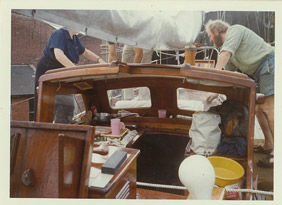
At work in Berthon's Yard
Contact was re-established between the Mill’s and the Armstrong’s, the time was now right for them to realise their ambitious dream, but now both families had children of their own. The Mills arrived in London a few days after Barclay was born. Now there were ten! At auction they bought an old BBC Commer van and scoured the country searching for a suitable craft. From Brokers and the Yachting Press they gathered information on many possible options, physically inspecting at least thirty craft. They covered many miles in their search, driving from the South Coast to Scotland and back before settling on MAYA, a handsome ketch lying at a marina in Lymington, then owned by John Russell, a flag officer of the RYS. Once John Tew, their Surveyor with his old cavalry sword, declared Maya sound, their offer of £8,500 was accepted and exciting prospects exploded. Now they really had to roll up their sleeves. They rented the top floor of an old Manor house near Lymington, sent the older children to school, Sandy and David got stuck into altering Maya’s interior to accommodate ten souls (two couples with six children) Only using their own hand tools, Berthon’s kindly allowed them to do this refit in their shed provided D and S did not use any of the yards equipment! Lists with lists of lists were made and ticked off one by one. A new pram dinghy, an excellent Gunning self steering gear, a new mizzen staysail, a new stove, a Sestral Moore compass and an outboard motor were purchased, plus much else besides, and so on and on it went.
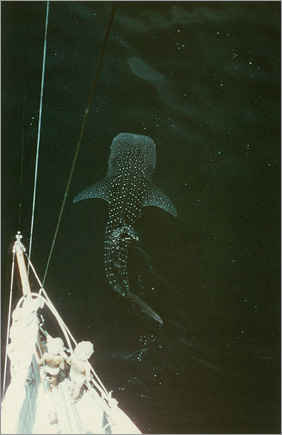
Kate and Daniel with Whale shark alongside Maya's bow
Around Christmas, after the lion’s share of the work was completed, they took a cold shake down cruise across La Manche to Cherbourg and the Channel Islands. They were delighted with all aspects of the boat and her admirable sea kindliness. They decided to postpone their immediate departure to allow more time and make full use of the Carribean hurricane free season. Both Sandy and David returned briefly to their architectural profession to help pay the bills. Then sailing westwards down the south coast their voyage really started when they left The Helford River, Cornwall in May 1972.
Reflecting on the voyage David comments ”Maya had a strong crew with considerable blue water experience. So far as was possible everything was split 50/50, and our characters must have been complementary, as we remain good friends to this day. Careful planning and attention to detail must have been our secret to such a successful voyage. Sandy’s enthusiastic engineering DIY know-how was invaluable. He taught the crew celestial navigation, remember that this voyage was undertaken before the advent of push button GPS and chart plotter aids. Joan, an excellent cook, fastidious housekeeper and regular diarist. Jen, a pragmatic and highly qualified SRN looked after all things medical. The older children were taught using the excellent NZ Correspondence School program. The older ones helped look after the youngsters and no one we met knew which blond child belonged to which family. We caught a lot of fish and enjoyed a very healthy lifestyle. With a sound ship, a balanced and enthusiastic crew, what more could one wish...”
Postscript
(Since Maya was sold)In 1997 David and Jen bought Secret Affair a 44ft sloop which they modified for blue water cruising. They have cruised extensively around the islands of the South Pacific in addition to crewing for Sandy and Joan aboard Zeferin during their seven and a half year circumnavigation of the globe. In 2001 Secret Affair joined the Greenpeace flotilla, sailing with a scratch crew, deep into the Tasman between Norfolk and Lord Howe Islands to protest against the dangerous transportation of plutonium. David and Jen still live in Auckland at Cox’s Bay just “round the corner” from the harbour bridge.
Sandy Mill
(written by Sandy, April 2010)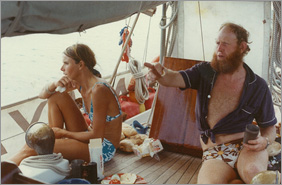
Sandy and Joan on aft coach roof, note wind scoop lashed to
gallows
I was an architect by profession. I studied Small Craft design and became an Associate Member of the Royal Institution of Naval Architects. I have been a member of the Royal New Zealand Yacht Squadron for 55 years.
I was born in Auckland. All my Great-grandparents emigrated to New Zealand from Scotland and the North of England in the mid-19th century. We lived on the upper reaches of Auckland's Waitemata harbour. As a small boy I seized every opportunity to go dinghy-sailing with servicemen from the nearby Airforce seaplane base. My father commissioned Nicholas S Potter, of California, to design a 55ft motorsailer, built in Auckland and launched in 1936. We cruised annually aboard Nereides on the Northern Coast of NZ (apart from the war years) until she was sold in 1957. In the latter years I operated the yacht on behalf of my father and gained valuable experience skippering and managing a vessel of this size.
I married Joan in 1960 and we soon invested a half-share in the 1903 Chas Bailey designed 32ft rater Janet. We sailed every weekend and raised our three children aboard this rather minimalist racing yacht for the next ten years. In 1967 we shipped aboard the 53ft Shireen for the ocean passage to New Caledonia. Interestingly she was also designed by Fred Shepherd. In 1971, looking for further ocean-going adventure, we teamed up in England with old friend David Armstrong and his family, with the objective of finding a suitable vessel to make the “Milk Run” back to New Zealand via Panama and the Pacific. The subsequent voyage to New Zealand was satisfyingly free from serious failures of preparation or operation. We all agreed that we would like to do it again.
On return to New Zealand Joan and I built a new house on our property in the hills adjacent to Auckland. In association with David Armstrong I continued architectural work and we made a foray into speculative house renovation in the proximity of the city. We continued cruising locally in a succession of yachts, but the ambition of designing and building a new ocean-capable yacht was looming.
With valuable contributions from our son Daniel, by now a boatbuilder by trade, we designed a 40ft beachable centreboard cutter. We confirmed our concept following completion of a polytechnic course in small craft design. The hull and decks were built professionally by a team including our son. All fit-out and installation was completed at home and Zeferin was launched in March 1994.
Following a cruise around the far south of New Zealand and several winter escapes to the islands of the South Pacific we set off for a cruise to the Mediterranean via the Red Sea and Suez Canal in June 1999. As part of an agreement between ourselves we laid-up Zeferin and returned to New Zealand more or less annually to retain ties with our family and especially our grand-children. This also conveniently avoided having to endure tropical hurricane seasons or the cold weather of the Northern Hemisphere winters. We concluded our circumnavigation via Panama and the Pacific seven and a half years later in December 2006.
We continue to live in our house in the hills of West Auckland, and we are happy to be able to cruise Zeferin in the delightful home waters of the Hauraki Gulf and North Auckland.





